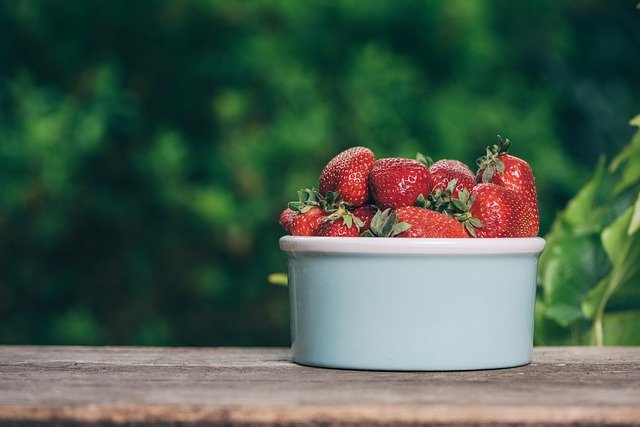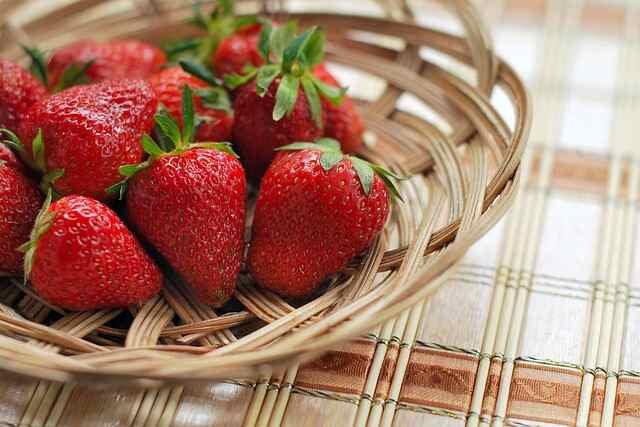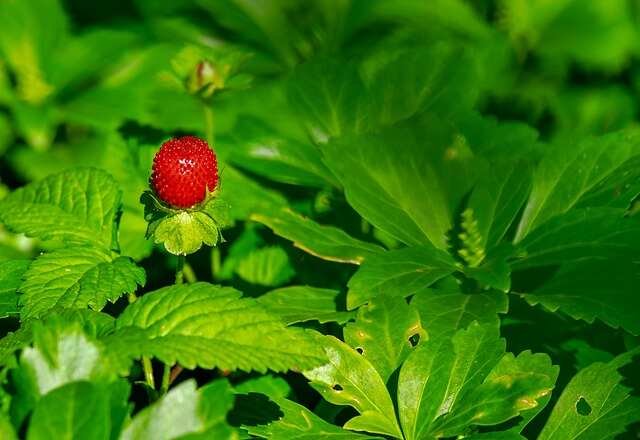Every spring and summer, strawberries are an unstoppable force in our gardens. Both the berries as well as the plants themselves thrive. As a low-crawling woodland plant, strawberries have three ways to propagate and reproduce: seeds, which are oddly located on the outside of the fruit, crown multiplication, which can get a bit tricky, and then by these guys, the strawberry runner, which is by far the most effective way. Often misunderstood if not overlooked completely, strawberry runners are stem-like projections that shoot out from the mother plant of both June-bearing and ever-bearing varieties, ending in a brand new daughter plant. And this little guy here is a perfect clone of the main strawberry mother plant.
As vegetative miracles, strawberry runners allow the main plants to grow, spread, and cover the nearby area with astonishing speed. As strawberry growers, whether we’re growing in containers or a large patch, sooner or later we’re going to have to deal with them. The relationship a gardener has with strawberry runners is wide and varied, ranging from minor annoyance, like a light weeding, to diligent collection and management to maximize the patch.
I know many of you are wondering, what’s the big deal? Can’t we just leave the runners be and put our energies elsewhere? Well, the answer is probably not, and today I’ll explain why. As well, I’ve got three easy techniques to double or even triple your strawberry population using these very runners. My goal today is to get you to reach that strawberry utopia you’ve always dreamed of, so let’s get going!
What Are Strawberry Runners?

As common and abundant as they are, there’s often still confusion surrounding what exactly a strawberry runner is. Strawberry runners, known botanically as stolons, are horizontal above-ground stems modified in such a way that they end in one or more clones known as daughter plants. Crops that do this are known as stoloniferous ones, and strawberries are the best at it. The stolons may contain one, two, three, or more clones on them, and they’re the main way a strawberry plant reproduces itself. As a low-crawling woodland plant with fairly insignificant flowers, seed reproduction is an uphill battle for strawberries. Crown divisions are great for farmers but not so great for a plant to accomplish itself. So, by adopting these amazing appendages, strawberry plants have evolved to grow and spread vegetatively. When the daughter plant touches the ground, especially moist soil, it’s automatically triggered to start producing adventitious roots right at the base. On almost every runner that’s over a week or so old, you’ll start to see the little root nodules forming. It’s pretty amazing.
As adventitious roots do, they grow fast, and once the daughter plant is fully rooted, it’s completely independent of the main plant and able to grow on its own. And all of this happens upwards of three or more feet away from the main plant. Not to mention, like we saw before, even the runners themselves can have runners. So you start to see why this is such an effective strategy for reproduction. But in life, there’s no such thing as a free lunch, and this applies to strawberry runners as well, which brings us to why when we start seeing strawberry runners, we must take action.
Why Remove Strawberry Runners?

As awesome as strawberry runners are, they can’t stay. As soon as they start to appear in your patch, they should be removed, and we do this for two reasons. First, those runners are a massive drain on the main plant. Producing epic berry harvests is a lot of work; it takes a lot of energy, and if you have one or, in this case, 20 satellite appendages sapping energy from the main plant, well, that’s less energy going to the berries. Trust me, I’ve seen it a million times; they directly affect your harvest potential. Second, like we said, strawberry runners are a highly effective way for the plants to reproduce, but in the captivity of our backyard gardens, it becomes a little too effective. Letting the runners do their thing in an already perfectly spaced bed or pot can quickly become problematic. Soon you’ll be inundated with too much of a concentration of strawberry plants. Essentially, the patch is going to become overgrown, and it’s going to start to compete with itself. And as you can guess, that also is going to affect the harvests. Unless you’re deliberately expanding your strawberry patch, in place, remove the runners as soon as you see them.
How to Deal with Strawberry Runners

It’s not all bad though. There are very few crops out there where you can buy a little plant and it’ll supply you with endless clones of itself, totally expanding your operation. And that’s why strawberry gardeners love the runners so much. For no extra cost to us, we can buy one or two plants and in a single year expand to more plants than we know what to do with. Really, there’s no other crop that does this, especially one with a highly lucrative harvest like strawberries. Not even including the berries themselves, this gives strawberry plants a return on investment like no other. However, even if we want and are going to use all these runners, not much changes. We pretty much need to deal with them as soon as we see them. And there’s three ways to do this, each with their own strengths, each with their own advantages.
First Method
The first method is quite simple, and it’s the one we use when we want to expand and fill out an existing patch. Essentially, we do nothing. Sort of. We let the runners do their thing, yes, but with a little nudge and a little direction here or there. It’s up to us where they set up shop. We get to decide where they send out roots and establish themselves. The stolons are quite bendy, so we can move them around to bare spots in the patch as we see fit. Like we mentioned before, as soon as the runners hit moist soil, root nodules begin to form at the base of the daughter plant. Move some mulch aside, and in a very short period of time, often as quick as a week or so, the plant is rooted and ready to live on its own. At this point, the plant is well on its way to becoming another mother plant itself, and it’s going to begin producing berries next season. As soon as that daughter plant is properly rooted, you can nip off that stolon. It’s a good idea too, as it’s going to continue to be a drain on the mother plant. It’s time for it to go searching for its own resources.
Second Method
For method number two, we get a little more sophisticated, but not a lot. Instead of letting them root wherever they want or even nudging them towards a preferred spot, we place the runners above little strategically placed pots full of a good potting mix. This method works great in flat large areas like this two by eight raised bed, but not as good in confined spaces like this pot here. In a raised bed or amongst a large patch, placement is easy. Keeping them in place, however, is not. The runners sometimes have a mind of their own, so I like to use a bent paper clip to pin them down and hold them in place just until they root. There’s nothing worse than a runner rooting part way, then falling out of the pot and drying out. I’ve seen it too many times to count. The process doesn’t take long though, usually under two weeks, especially if you can keep that soil moist. Once rooted, just like with the other method, you can go ahead and snip off the runner. Now you have a free strawberry starter plant that can be used to start a new patch or bed anywhere you want. Brilliant.
Third Method
Lastly, we have the third method, and the one that I use, and that’s to raise up the daughter plants cut off from the mother plant. Now, not only does it save us time and space, but it also cuts that energy-sapping lifeline as soon as possible. By cutting off that lifeline earlier, we save the mother plants a ton of energy. Not only that, the daughter clones get going that much faster. This method can be a little tricky because if you cut these runners too early, they simply won’t root and they’ll die. The secret is waiting until the daughter plants have at least four root nodules forming at the base. Don’t do it on a hot day and get them into moist soil or water right away. And it makes sense because once you cut that stolon, that’s it. The small daughter plant is receiving no water, no nutrients from the mother plant. So, on hot dry days, they can perish quite quickly. Now, once you’re sure they’re ready and you’ve cut the runner off, we can do one of two things. We can plant them in soil, or we can put them in water. Let’s do both.
For planting straight away in soil, grab a bag of your favorite quality organic potting mix and pre-fill your little pots right to the top. I use the four-inch square ones as they seem to be a really good size. Also, let’s go ahead and pre-soak those filled pots from below to ensure that they’re holding their maximum capacity of water. This is really going to help the new roots form. After a couple of hours when all the water is absorbed, make a hole in the center but not too deep. Strawberries, unlike most plants, cannot be buried. If they are, they’re going to rot. And that’s where this method gets a little tricky because with no roots to hold them in place and not being able to plant them deep so you have no support, how the heck do we plant these guys up? The secret is in that stolon stem. It’s quite thick and pretty strong, and we can use that to our advantage. What you want to do is leave an inch of it on either side of the daughter plant and use it as an anchor to prop up the plant. It works like a charm every time. It keeps the base of the little daughter plant just below the soil surface, but the rest of the plant safely above ground. Good stuff. Just like before, within about two weeks or so, they’re going to be fully rooted and well on their way.
I should note, however, that when I’m first potting up the strawberry runners, I leave them in a sheltered area, somewhere like my greenhouse. Wind and direct sun can wreak havoc on the young plants, and I want to give them the best chance. Now, we mentioned that there were two ways to pot up these runners. We can first plant them in soil, or we can put them in water first. This method is pretty much the same, with just an extra step of first rooting them in water. I prefer doing it this way, and I feel like it has two distinct advantages. One, it makes them much easier to pot up and more likely to live if they already have an active root system.
And two, not all runners make it. Not all of them get to the point of sending out roots, so this is a way to allow us to know for sure that the planting is going to be a success. Soil space and time cost money; I prefer not to waste those. It goes pretty quick, and it doesn’t add much time. The roots form within a week, and although the planting window is quite large, you don’t want to leave it too long. Roots of all plants can get very used to water, and eventually transplant shock is going to be too great when you’re moving them to soil. So once those roots reach about an inch long, it’s time to plant them up, and just like we did before, planting is much the same. Leave a little bit of that stolon on to anchor it, and plant them high up. You want the roots buried, but the rest of the plant above ground. Indirect light and moderate temperatures for a couple of weeks, and your new strawberry plants will be ready for the world.
It’s an amazing journey to go from a young runner to a daughter clone to a fully independent individual plant. We covered it all, and it was a lot of ground for sure. Let’s recap the finer points to help it sink in. Strawberry runners are vegetative offshoots from the main strawberry mother plant. Along the long stem of this runner, there may be one, two, or even many clones of the main plant, known as daughter plants. These daughter plants give strawberries the means to reproduce themselves and colonize the surrounding area with great effect. But, like anything, it comes with a cost. The runners are a big-time drain on the mother plant, and if left to grow, they will most certainly affect that season’s harvest. So, we cut them off as they appear to conserve as much energy as possible for berry production. You want to cut those runners off near the base of the mother plant as soon as you see them.
Being gardeners, however, we waste not, want not. The little daughter plants are super easy to root and grow, and they’re the primary method for expanding our patches as well as constantly having new stock to replace the old beds. They can be rooted in three ways with relative ease: in place if there’s room, in little pots strategically placed, or often away from the main plant in water or soil. Either way, strawberries are the one crop where one simple purchase can result in a mountain of harvest. Runners are amazing little offshoots that let us know our plants are healthy. As a low-maintenance crop, it’s the one thing we have to deal with when we’re growing strawberries. And to me, it feels like a small amount of effort for the returns we get.
Hey, best of luck with your strawberries, and happy growing, guys. Thanks so much for reading.



